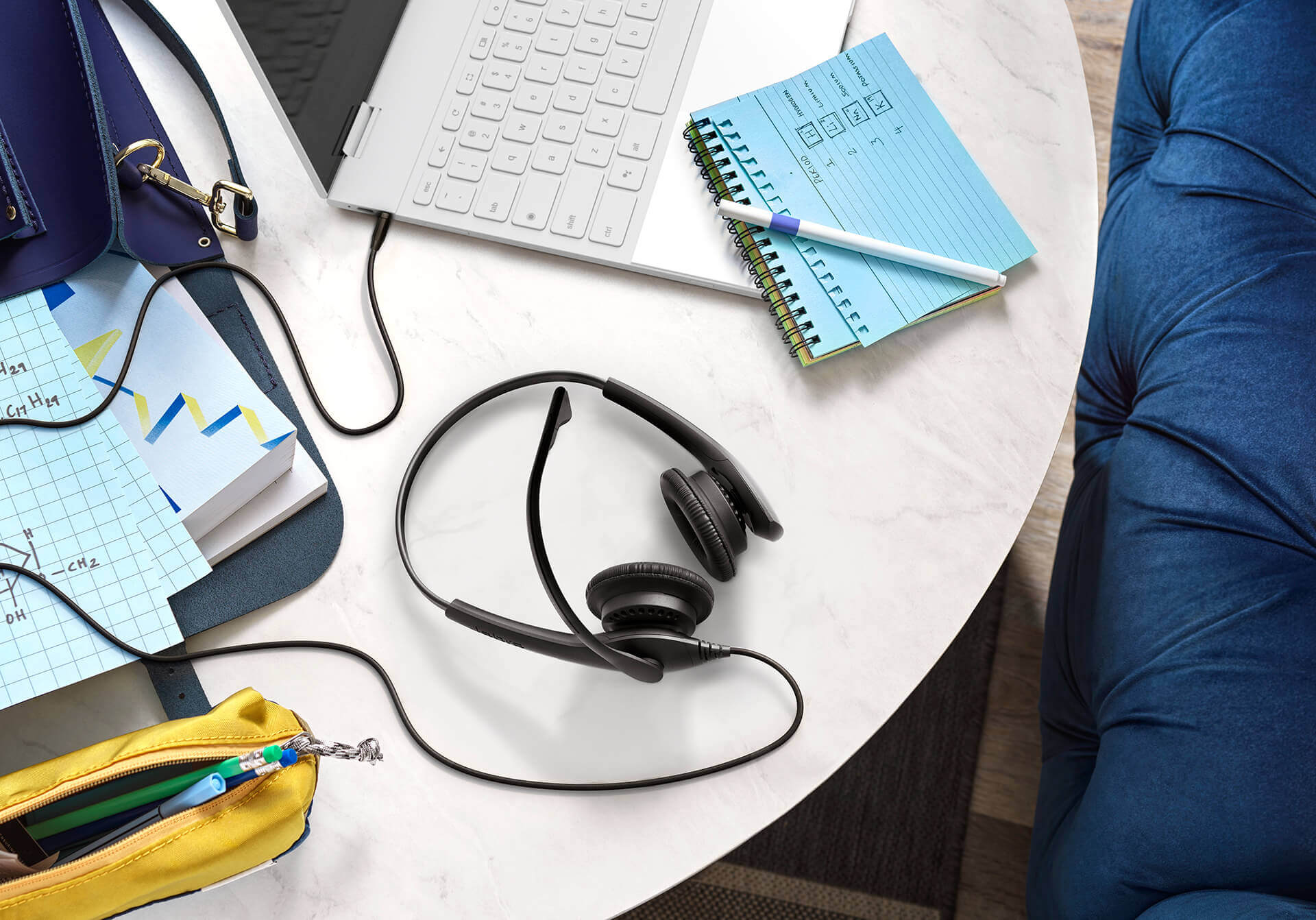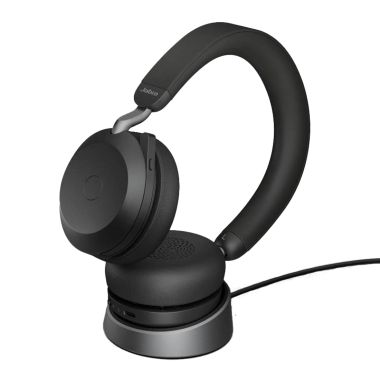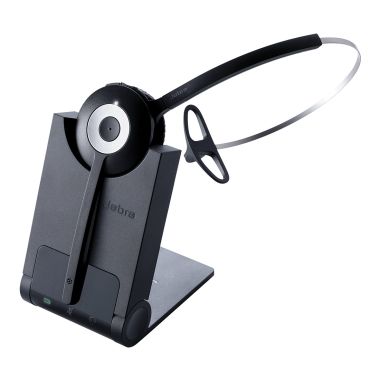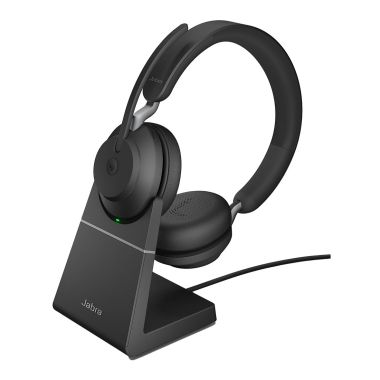- Why Choose Us
- Ordering & Payment
- Shipping, Returns and Warranties
- Safety, Privacy & Email
- General Information
- Learn More About
Headset Buyers Guide


Why Do People Buy Headsets
If you walk into any office today, whether it’s a small office, a large office, or even a home office. You will most likely see the same thing. You will see someone wearing a headset.
Why a headset you might ask? Simple. Because communication is paramount to success in the workplace and a headset is the ultimate communication tool. Imagine a world without headsets. If you walked into an office in that world you would see people struggling to communicate. That’s not a world we want to live in!
Freedom and Productivity

Who doesn’t want to enjoy more freedom and productivity?
Companies are now realising their staff are much happier if they have the freedom to move around. And they’re more productive too! Thanks to wireless headsets, you have total freedom of movement as you are not tethered to a device or handset. Instead of being stuck at your desk all day, you can now take calls anywhere you like. Even while multitasking. That’s a huge boost to productivity in the office.
Having a conversation with your hands free allows you to express yourself in a completely free and natural way. And by taking conversations in different places you can spark creativity and ideas that may be stifled sitting in your desk chair all day.
Having said that, even wired headsets give you freedom that a traditional handset does not. Imagine that you are on a call, listening to the person on the other end. You need to write some notes. Now you find yourself holding the phone to your ear with one hand and writing notes with the other.
You may even find yourself cradling the phone between your shoulder and neck to free up both hands. But your neck is cramping and one small movement and you’ll drop the handset. Sounds familiar? Our neck hurts thinking about it. Not only are you uncomfortable. But your stress levels are through the roof as you are scrambling to listen, hold the phone, and write, all at once. Imagine doing that every day? That’s a recipe for disaster.
That’s where headsets come in like a knight on horseback. To save you and your office from unnecessary stress and physical discomfort. Headsets, whether they’re wired or wireless, offer you freedom and productivity. The freedom to roam, stretch out, or even reach for that slightly out of reach pen and paper. And the productivity to be writing up notes as the conversation is happening. That’s more like it.
Creativity

Creativity involves coming up with new ideas as well as solutions to problems. Shaking up your routine allows you to perceive information in new and sometimes surprising ways. That’s where creativity lives.
If you follow the same routine day after day, your subconscious mind falls into familiar habits and you need to work much harder to find moments of creativity. Lucky for us, headsets allow us to shake up our usual routine by offering us freedom of movement. A wireless headset allows you to take meetings in new places and in turn ignite our creativity. Even a wired headset allows us to be more creative as we can use our hands while we talk, and experts all agree that 70 to 93% of what we communicate is nonverbal. Even if you’re on a call where people can’t see your hand movements, studies show that hand movements and gestures while talking allow our brains to process information and speak our thoughts more clearly and efficiently. It’s because our hand movements trigger areas of the brain responsible for speech. So using a headset will allow us to communicate better. Not only because the microphone makes our voice sound amazing. But also because it frees up our hands to help articulate our own thoughts in conversation.
So get those hands moving!
And if creative ideas start flowing, your hands are free to write them down!
No more saying the word ‘what’?

Sorry, can you say that again?
Sound familiar? Well, fear no more! With a noise-cancelling headset and microphone you can be confident knowing that you can hear your customers clearly. And they can also hear you clearly.
No more asking for someone to repeat themself, or apologising for the noise coming from your end. Working from home has caused many of us to apologise for the noise of the dishwasher, doorbell, barking dog, or crying child in the background. With a noise-cancelling microphone you can maintain a professional conversation without the other person hearing you and your homelife. This also translates to the office - where you are in a space where multiple conversations are happening at one time, the listener will only hear what you are saying, and not the cacophony of conversations happening around you.
Health and safety - avoiding neck and back pain

Australia has implemented standards in relation to the use of headsets in the workplace and how companies are working to keep their people safe and healthy, both physically and mentally. The Australian standards are outlined in the Industry Guideline G616. The primary focus of the guideline is on Acoustic Shock Protection and the prevention of noise spikes and excessive noise pressure, which we will explore later on in the guide. But in a nutshell, professional office headsets feature in-built audio limiters that can protect you from hearing loss caused by loud noises!
But, it is not only your ears that your headsets can protect. Headsets can save you from dreaded back and neck pain. As they allow you to stand up, stretch, and (with wireless) walk around. Without a headset you will find yourself stuck at your desk holding your phone over your ear, letting your neck, shoulders and wrists bear the weight and strain of your handset.
Hear and be heard. Being understood and understanding better

There is a saying in the headset world - ‘Hear and be Heard Better’ - that’s what headsets do! They give you the confidence that your customer can hear you, and you can hear them. We go one step further - ‘Understand and be Understood Better’.
Headsets are effectively the first point at which communication begins. You may have a precursory email to set up the call, but the call itself is where the real communication begins. Why is this? If you are relaying the same information, using the same words, but using different channels, the result should remain the same, right?
This is an easy assumption to make, but studies have shown that the words we use are of little importance to the conversations that we are having. This is known as the 7% rule.
Many of us use Zoom, Microsoft Teams, and other video conferencing software for business, but despite the ability to view body language it can actually be more disruptive than a phone call - with rough connections, unprofessional home backgrounds (or even worse, novelty stock backgrounds - just what are you hiding behind there!?) phone calls remain the preferred form of communication.>
So, without body language, the most important part of our message is communicated through the tone and music of your voice. Therefore, it is important that your equipment is communicating your tone as accurately as possible.
To illustrate this, let’s call on an often used example on the importance of grammar:
Let’s eat grandma!
Let’s eat grandma!
The use of the comma changes the intent completely, from eating your grandmother, to eating with your grandmother! Without seeing the comma in writing, the comma is conveyed through pace and tone of speech. If your tone is ambiguous or undetectable, your message can be taken in the opposite way to how it was intended, and that is bad business, plain and simple.
How To Decide Which Headset Is Right For You

Now that we’ve covered the basics it’s time to get down to the nitty gritty: what type of headset is best suited to your needs. Here is some useful information to know about headsets and their different capabilities to help you make an informed decision on what’s best for you.
Corded vs Wireless
Unless you are required to use a corded headset for legal reasons, we suggest going for a Bluetooth headset if you are in a smaller office of up to 15 people, or if you are working from home and want PC and Mobile connectivity. If you’re in a larger office and are concerned about Bluetooth interference, or you want more wireless range, go for a DECT headset. If there is one question that we get asked all the time it’s are wired or wireless headsets better? Unfortunately, we cannot give you a cut and dry answer as it comes down to what you are looking for. Are you happy being tethered to a device, or do you want a completely hands-free experience with the ability to roam?
Wireless headsets give you the option to stand up, stretch, and walk around. ‘Wireless’ headsets cover the general term used for both Bluetooth headsets and DECT headsets, we’ll go into a little more detail about these options below, or you can read our blog article on Bluetooth vs DECT headsets to learn more about the differences.
Corded (or wired) headsets are physically connected to the device - whether that is a deskphone, laptop, PC or mobile phone.
Whilst you don’t have the complete freedom of a wireless headset, you still have your hands free, which is what is most important. There is no risk of the call dropping out or having connection issues, as the headset is physically wired or connected to the device. Additionally, the majority of corded headsets have the cord controllers on the wire itself, halfway between the connection of the headset and the device. With wireless, these controls are usually found either on the wireless base station or on the headset itself
A quick note about wireless headsets you may have used in the past: You might have had issues with poor connection or calls dropping out. Understandably, once you have had these less than ideal experiences, it can be difficult to trust wireless technology again. Thankfully, wireless technology has advanced much farther than it used to be, and so these connection issues are now few and far between. If complete freedom is what you want, then wireless is the way to go.
Best In Class
-
RRP: $181Now:
$139 Inc GST Save: $42- Works WITH - PC + Mobile
- Popular headset
- In-line audio controls
Wireless - Bluetooth vs DECT

Unless you are a true headset geek like us, you may not know the difference between Bluetooth and DECT headsets. So, let’s start with how they are the same, shall we?
Bluetooth and DECT headsets are both wireless communication devices. The main difference is that Bluetooth transmits both audio and data, whereas DECT only transmits audio.
But wait a second, Bluetooth transmits more information, so it must be better, right?
Well, not necessarily. DECT only transmitting audio can be seen as an advantage depending on the use case.
The key difference between Bluetooth and DECT is the number of people who can successfully use it in any one space. As DECT is a dedicated audio technology, you can have more people using it in the same room without interference and you can have a lot more wireless range. The average range of a DECT system is 100-180 metres, and it does not matter how many calls are happening at one time, as the wireless technology is purely used for these audio streams. See, that’s the advantage.
Bluetooth ranges, on the other hand, are smaller - typically 10 to 30 metres - and if you have a high density of people using Bluetooth at one time, the likelihood of call interference is much higher than it would be with DECT technology.
Even in small offices of 8 people, if you are all on calls at the same time, your Bluetooth technology can interfere with different systems. It isn’t only the calls - as Bluetooth is not a dedicated audio stream, you could have Bluetooth mice, keyboards, earbuds, wireless wifi networks and phones all running on the same stream. The higher the number of devices using Bluetooth, the higher the risk of interference. It may seem like we are exaggerating, but we’re not.
Well now it sounds like DECT is better than Bluetooth, right?
Not necessarily. DECT headsets require a dedicated base station in order to work, whereas Bluetooth headsets only need to connect to your device. This is why Bluetooth is so popular for commuting and listening to music, as they are simple and easy to set up and as long as your phone or laptop is nearby, you can have a connection. Whereas with DECT, you have way more range and less interference, but you still need a base station near your device, which means they’re not as portable. It’s also an extra device that you need to have with you. This makes DECT headsets ideal for offices, where you don’t need to be as mobile. You simply set up the base station on your desk and you never have to worry about moving it. And since they have generous wireless range, up to 180 metres, you can take your headset for a walk around the block and back.
While Bluetooth is great for your home accessories like earbuds, speakers, and phones, you don’t generally have 10+ people in your home at one time, all trying to use Bluetooth networks! That’s why we usually recommend Bluetooth headsets for work from home setups and small offices, whereas we recommend DECT wireless headsets for larger offices of 8 or more people.
So think about how much of the day you are on the phone. If you are in a small office or you’re working from home and you take the occasional call throughout the day but are not consistently on the phone, then Bluetooth may be a viable option for you - especially if you want the ability to connect to more than one device. However, if you work in a call-based environment such as a call centre and need only one connected device, then DECT is the better option. However, the decision doesn’t end there - there are three different ways that Bluetooth can be used.
Bluetooth - Headset to Device

This is a very simple way of using Bluetooth, that you will recognise from your day to day life. A Bluetooth headset connects to any other Bluetooth device, which means your Bluetooth headset can connect with your mobile phone, PC, or tablet, and you can either switch between the connected devices, or some headsets allow you to pair with 2 or more devices at once.
Bluetooth - Device to Base Station

Unlike headset to device connections, Bluetooth device to base station is not a direct link. In the majority of these device-to-base station Bluetooth connections, you actually have DECT and Bluetooth working side by side in different applications. DECT will communicate from base to headset, then Bluetooth connects from base to device. Therefore, there are two connections running together simultaneously. Sort of like a Franken-Bluetooth-Dect-Headset. When you have a call coming in - the call goes from your phone to the base station using Bluetooth, then from the base station to the headset via DECT.
This means that your mobile phone, desk phone or computer will need to be within 10-30 metres of the base station while you are chatting on your headset. It just means you may not be able to take your phone with you as you wander away from your desk to the kitchen to get some water mid-phone call. Just leave your phone on your desk for 2 mins while you keep chatting on your headset and you will be fine.
Bluetooth - Device to Base Station

With this Bluetooth connection, the headset itself is Bluetooth and will work by directly connecting to a mobile. But it will need a Bluetooth USB dongle to work with your computer. You might be wondering why you need a dongle if your computer has Bluetooth already built-in? Good question. Let us explain.
The first consumer Bluetooth device launched long ago, in 1999. Since then, Bluetooth has transitioned from version 1.0 to 5.0, and so it has increased in its reliability over time. And of course, the current version of Bluetooth is far more advanced than the original.
However, even though most of today's laptops have Bluetooth built-in, it doesn’t mean that your headset will just work off the bat. Unlike mobile phones, there is no one standard that just works across the Mac OSX & Windows operating systems. From connection issues, or poor audio, trying to get a headset to work with a computer’s built-in Bluetooth is not worth the hassle. And even if you get the basic connection working, you will miss out on all the cool stuff like double tapping to answer a call. Or starting and stopping music with the press of a button.
So, in short, when you see a headset sold with a USB Bluetooth dongle, you will need to use the dongle to get the full headset experience.
DECT Headsets

As previously mentioned, DECT is the best solution for high-density call environments, or larger offices where you may want to walk around further than 30 feet from your device. If you want lots of wireless range and have a number of people taking calls at the same time - think a busy CBD office or a warehouse - then DECT is the way to go. Some DECT headsets also have higher levels of security and encryption than Bluetooth, and depending on your industry, may be a requirement.
Best In Class Bluetooth Headsets
-
RRP: $454Now:
$438 Inc GST Save: $16- WORKS WITH - PC + MOBILE
- 360* Busylight
- Premium headset
-
RRP: $690Now:
$530 Inc GST Save: $160- WORKS WITH - Mobile + PC/Mac
- Dongle and charge via - USB-A
- Charging stand included
- Advanced Active Noise Cancelling
- Hide-Away Mic Boom
Best In Class DECT Headsets
-
RRP: $659Now:
$498 Inc GST Save: $161- WORKS WITH - Desk Phone + PC + Mobile (2)
- Headband style - 2 earcups
- Easy Mute Buttons
- 13 hour talk time
-
RRP: $499Now:
$401 Inc GST Save: $98- WORKS WITH - Desk Phone + PC
- Mono Headband Style
- Built in busy light
- Easy Mute buttons
- Up to 13 Hour Talk Time

Wearing Styles: Mono vs Stereo

Basically this comes down to whether a headset has one ear cup, or two ear cups. If you are in an environment where you need to be approachable and regularly talk to people, then a mono headset will be better suited. But if you are in a noisy space and need to concentrate, or you are looking for an active noise cancelling headset, then a stereo headset is the ticket.
There are six types of wearing styles for headsets. They are: back of the neck, earbud style, over the ear plus earbud, over the ear without earbud, over the head with one ear (mono) and over the head with two ears (duo or stereo).
The most popular headsets are overhead mono and stereo, so that’s what we’ll focus on here.
Mono is the most popular style for people who are talking over the phone most of (but not all of) the day, and have reasonable levels of background noise. Having one ear free means that you have a better gauge of the volume of your speech. And you can talk to your colleagues without needing to take your headset off.
Stereo headsets are the preferred style for noisier environments, as having both ears covered gives you passive noise cancelling. If you do not need to interact with your colleagues much (such as solo at home work or call centre work) then a stereo headset is a great option for you. But, if you are sharing an office with others, then passive noise cancelling can actually have a negative effect on the levels of noise within the space. If everyone in the office has stereo headsets on, they are unable to understand how loud they are speaking, and so that usually ends up with everyone in the office speaking louder! We’ve all been there.
Best in Class Mono Headsets
-
RRP: $269Now:
$209 Inc GST Save: $60- WORKS WITH - Desk Phone
- Up to 8 hours talk time
- Outstanding value
- 120m wireless range
- NB Battery cannot be replaced

Best in Class Stereo Headsets
-
RRP: $454Now:
$438 Inc GST Save: $16- WORKS WITH - PC + MOBILE
- 360* Busylight
- Premium headset
Other Things to consider
Aside from the working environment considerations, there are also some personal issues that need to be taken into consideration.
Do you wear glasses?
If you wear glasses you will not want a headset that goes over the top of your head or hooks around the ears and interferes with your glasses. A headband wearing style will be the best option for you.
Do you have hair that will get in the way?
For those of us with voluminous hair, this can get in the way of the over-the-head headsets and affect how they sit. We suggest opting for an ear hook option instead. Your thick head of hair will thank you for it.
Audio Frequency: Narrowband vs Wideband

Narrowband Audio
Narrowband audio focuses on just the main frequencies of the human voice, rather than across the whole range. Narrowband Headsets typically output sound between 300-3400 hertz, which is more than adequate for most situations, as these are all of the frequencies that would be transmitted via a traditional phone, or mobile. But if you tried to play music on them it wouldn’t sound very good. But the benefits are that human voices will be easier to understand as you don’t have the low end mud frequencies interfering.
Wideband Audio
Wideband audio headsets generally output sound in the 100-6400 hertz frequencies, which gives you a natural, full sound of the human voice. Think of it as the HD of audio technology. For VoIP phone setups or video conferencing tools such as MS Teams & Zoom where the full range of voice frequencies come through, wideband is a better option. With these platforms becoming the norm, if you invest in a good wideband headset you will hear all the benefits of crystal clear audio, as if you are just chatting in the same room as your colleague.
Ultra Wideband Audio
Recently there have been more office headsets coming onto the market with Ultra Wideband Audio. These headsets output the same frequencies as your music headphones between 50 - 20,000 hertz, so you hear the full range of audio sounds. These are the headsets to go for if you are going to be listening to a lot of music, or podcasts throughout the day. Or if you want a headset that you can use in life outside the office. Ultra Wideband audio headsets also allow you to listen to your favourite music just as it was meant to be played. But, for most work situations and casual music listening, Wideband Audio is just fine.
Headset Integrations & Certifications

If you use Zoom or Microsoft Teams a lot, we advise you to get the headset that's been certified for that platform. There tends to be no or very little difference in price and you usually get some added functionality on the headset specifically designed for the platform. If there isn’t a Zoom or MS Teams certified headset in the model you want, then the UC or regular version will work just fine.
Unified Communications (UC)
What exactly is unified communications? I’m glad you asked. It’s actually a pretty simple concept. Unified communications is the name given to the trend around simplifying communications over time. When you see UC in headset descriptions, it means it can connect to multiple devices, such as your phone and your computer.
Microsoft Teams Certified
A Microsoft Teams Certified device means that you will get the best experience and compatibility with the MS Teams app whilst using that device. If your headset is MS Teams certified, then MS Teams has acknowledged that the headset will give you the best experience possible. It may be something as simple as being able to tap on the headset to answer a call, or there may be other advanced features that have been developed to work specifically with MS Teams.
Pay close attention to the wording of the headset. There are many headsets that state that they are MS Teams compatible, however, this simply means that it is a headset that will work with a computer. Certified is one step further - it means there are specific integrations as mentioned above to specifically work in the MS Teams suite of apps.
Zoom certified
Zoom Certified is essentially as described above, but relating to the Zoom software rather than MS Teams. If you use Zoom a lot then you will be wise to get a Zoom certified headset!
Should You Get a Microsoft Teams or Zoom Certified Headset?
If you use one of these platforms for the majority of your work (Zoom, Microsoft Teams, Skype), then opt for the certified headset. Most headsets within a series come with the same core features, you just get the added benefit of specialist buttons or modes.
This isn't to say that if you use both Zoom and MS Teams you need to buy the certified headsets for both - simply work out which platform you are spending the most time on, and buy the headset certified for that, as it will still work across all tools and apps.
Best in Class MS Teams Headsets
-
RRP: $545Now:
$452 Inc GST Save: $93- WORKS WITH - PC + MOBILE
- Certified for MS Teams
- 360* Busylight
- Premium headset
-
RRP: $690Now:
$530 Inc GST Save: $160- WORKS WITH - Mobile + PC/Mac
- MS Teams Certified
- Dongle and charge via - USB-A
- Charging stand included
- Advanced Active Noise Cancelling
- Hide-Away Mic Boom
Best in Class Zoom Headsets
Microphones: Tube vs Noise Cancelling

Where possible choose a noise cancelling or ultra noise cancelling mic, your customers and colleagues will thank you as they will be able to hear your clearly.
Tube Microphones
This is the most basic style of microphone. A tube mic is a microphone on the end of a stick - it is not set up to cancel any background noise, however it gives a stable, amplified sound. There are still quite a few headsets on the market that use this type of microphone. But most of the headsets we sell at Simply Headsets have noise cancelling microphones and not tube microphones.
Noise Cancelling Microphones
Noise cancelling microphones are designed to passively cancel background noise. The noise cancellation is not done through electronics, but rather in the way the microphone hardware is designed.
These mics are fine for the average office environment where the background noise is between 1.5-2 metres between desks. The mic can block out low and consistent sound and there are multiple sound pick up points within the mic so you do not need to worry too much about where your mic is positioned.
Best In Class Noise Cancelling Microphone Headsets
-
RRP: $529Now:
$438 Inc GST Save: $91- WORKS WITH - Desk Phone + PC
- Stereo Headband Style
- Built in busy light
- Easy Mute buttons
- Up to 13 Hour Talk Time

-
RRP: $659Now:
$498 Inc GST Save: $161- WORKS WITH - Desk Phone + PC + Mobile (2)
- Headband style - 2 earcups
- Easy Mute Buttons
- 13 hour talk time
Noise Cancelling Headsets: Passive vs Active

If you’re trying to decide between Passive and Active Noise Cancelling Headsets, consider your work environment and how you are going to be using the headset. If you spend the majority of your day speaking, then an Active Noise Cancelling (ANC) headset is likely not the right headset for you. But, if you spend the majority of your day listening, then you want active noise cancelling so that you can fully focus on the audio. ANC headsets are also great crossover headsets for when you want to use them for other purposes such as the commute home to listen to podcasts or audiobooks and want to cut out any background noise. They’re also great for flying!
Passive Noise Cancelling
Similar to the passive noise cancelling microphone, this type of headset uses the physical structure and build to cancel out noise. Passive noise cancelling relies on the nature of the hardware earcup, and uses the physical foam connection between the earcup and outside of the ear to create a barrier preventing outside noises entering your ear. A headset needs to be stereo (two earcups) for it to have a passive noise cancelling effect.
Passive Noise Cancelling headsets works well for the majority of people. If you are in an office environment, even a loud office environment, Passive Noise Cancelling headsets can block out a great deal of the noise. Of course, how well it does this depends on the quality of the earcups.
Active Noise Cancelling (ANC)
Best in Class Passive Noise Cancelling Headsets
-
RRP: $454Now:
$438 Inc GST Save: $16- WORKS WITH - PC + MOBILE
- 360* Busylight
- Premium headset
As the name suggests, active noise cancelling actively works to cancel out any unwanted noise. These headsets have microphones positioned on the outside of the earcup (and possibly on the inside too) to listen for background noise. When background noise is detected, an equal and opposite soundwave is played through the speaker to create silence, leaving only the intended audio. Pretty nifty!
This feature is designed to solve the problem of too much background noise impeding on what is coming through the speakers. While the technology is great for situations with intrusively loud audio (such as home offices where the noise of neighbours or traffic cannot be controlled), there are some drawbacks within corporate office environments. Perhaps the biggest issue for office environments is that these active noise cancelling headsets are large, over the ear sets, and so if you are speaking and have the ANC feature on it will prevent you from hearing yourself clearly. When you are talking, you want to be able to hear the level of your own voice. Some Active Noise Cancelling headsets allow you to set the level of noise cancelling, even to a setting that turns noise cancelling off for situation where you need to hear yourself clearly.
Best In Class Active Noise Cancelling Headsets
-
RRP: $608Now:
$470 Inc GST Save: $138- WORKS WITH - Mobile + PC/Mac
- Dongle and charge via - USB-A
- Advanced Active Noise Cancelling
- Hide-Away Mic Boom
-
RRP: $725Now:
$530 Inc GST Save: $195- WORKS WITH - PC + MOBILE
- Active Noise Cancelling
- 360* Busylight
- Premium headset
Security & Encryption

When it comes to security, the most secure system will always be wired, as there is a physical cable connecting the headset to your device, and no data is sent wirelessly between devices. Wired headsets are legally required in some industries such as defence. Still, wireless technology is used by many companies because both DECT & Bluetooth have security built into the system.
Built In Standards Around DECT & Bluetooth
Some companies have a legal requirement for data to be encrypted when it includes voice at certain levels. This comes under the peripheral device security standards, which exists for any device connecting into the network. Depending on your organisation, you will have a different level of security that you deem acceptable. Generally speaking, the inbuilt security for DECT and Bluetooth systems are fine for the majority of businesses. Though DECT headsets typically have more security encryption built in.
Acoustic Shock Protection
The Industry Guideline G616 mainly focuses on Acoustic Shock Protection and the prevention of noise spikes and excessive noise pressure. This is the standard determined by the government, and is the minimum standard that headsets sold in Australia by Aussie companies such as Simply Headsets need to be manufactured to.
As with anything in life, when you find a product at a price that seems too good to be true, it almost always is. So if you see headsets sold overseas at a fraction of the cost, it is likely that they are not manufactured to Australian standards. These standards are in place to provide protection against hearing loss, and there is a reason that it is a guideline adhered to by reputable brands. Don’t gamble with your health to save a few extra dollars - where your ears are your income, you need to be mindful of keeping them protected as much as possible.
More Than A Work Headset

Headsets are not just used during office hours, so if you want a dedicated headset for both business and personal use, consider a crossover solution. You may want to wear them on the commute to listen to music, at home listening to podcasts, or on the move. That is why crossover headsets exist, and they are designed in a way so style meets function.
Think about how much time you will spend using your headset on these different activities and write a list (we love lists!) of what is most important to you in a headset. If you will only be using the headset for conversations at the office, then you won’t need a crossover headset and a wired or DECT narrowband is a great option for you. If you are a digi-nomad, working from different spaces during the week and listening to music in between, you will want a Bluetooth headset that allows you the freedom of movement and connection to multiple devices. And if you’re an audiophile or music lover, then you want a headset with an ultra wideband audio microphone to get the best listening experience possible.
Conclusion

We have gone through the steps and questions you should ask yourself when buying a new headset. but as there is so much information you may still need further assistance with your choice. A headset is a very personal piece of equipment, so think about what is most important to you and your business. Once you have that in mind, give us a call on 1300 889 728 and let us know what your priorities are and we will recommend a headset most suited to you.
The general rule of headsets (as is with most things in life!) is that you get what you pay for. A premium headset has a standard warranty of two years, but realistically it will last 4-5 years. For a piece of equipment that you are using 5-7 days a week to conduct essential business, investing in great quality is a no brainer. Invest in something that does what you need, when you need it, and protects your customers and their data, yourself and your ears! When you have your headset on day-in-day-out talking to customers, clients, or listening to music, then comfort and clarity is the key to a happy and productive workplace environment.














